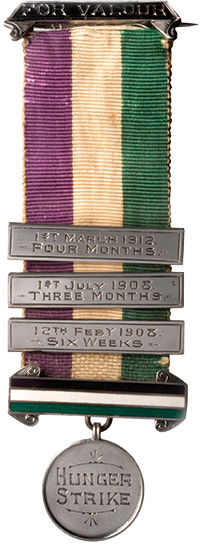|
Legacy
Pinned For The Vote
Suffragist jewelry is a much coveted — and controversial — collectible.
By Phyllis Schiller

|
| Silver hunger strike medal given to suffragist Florence Haig in 1912. Dates of the three times she was imprisoned are inscribed on the medal. Photo © Museum of London. |
Early in the twentieth century, as society moved into the modern era, women in England and America stepped up their fight for the right to vote. The most vocal of the English suffrage associations, the Women’s Social and Political Union (WSPU), evolved from holding peaceful demonstrations to more militant acts of civil disobedience, resulting in harsh jail sentences. In America, a merger in 1890 of the National Woman Suffrage Association and the American Woman Suffrage Association created the National American Woman Suffrage Association (NAWSA). “The American suffrage movement and the English suffrage movement had strong connections with one another; there was a great deal of communication between the two,” points out Kenneth Florey, author of Woman’s Suffrage Memorabilia: An Illustrated Historical Study. “In general, the English came up with many ideas originally and the Americans adapted them.”
The British suffragists won their battle in 1918, when the right to vote was granted to women age 30 and older; in 1928, suffrage was extended to all women in England over the age of 21. In 1920, the 19th Amendment was ratified, giving American women the right to vote.
“British Arts & Crafts jewelry has a relationship to suffragist jewelry. There are known pieces and known artists who supported the suffrage movement,” says Elyse Zorn Karlin, co-director of the Association for the Study of Jewelry & Related Arts (ASJRA). “Ernestine Mills made a number of pieces for suffragist leaders such as Emmeline and Christabel Pankhurst. Mills was known for her enamel plaques. One design is a closed crocus, which is said to be the symbol of ‘feed me not’ for the British suffragists who went on a hunger strike after being arrested and were brutally force-fed by the police.”
A hunger strike medal was given by the WSPU to those women when they were released from prison, says Florey. A bar represented each time they were imprisoned and force-fed. On the front, it said, “Hunger Strike,” and on the back it was inscribed with the name of the recipient.
One of the most famous suffragist badges of honor was the Holloway prison brooch, says Karlin, presented to WSPU members who had been imprisoned there. It was designed by Sylvia Pankhurst. Also called “the portcullis pin,” says Florey, “the design of the portcullis symbol of the House of Commons — the gate and chains are in silver — is superimposed with an enamel arrow in green, purple and white, the colors of the WSPU. The arrow was part of the prison dress the women wore.”
In America, a Jailed for Freedom pin was commissioned by suffragist leader Alice Paul for women from the movement who had been imprisoned in the Occoquan Workhouse, where they were beaten by the jailers. The silver pin shows a prison door chained with a heart-shaped lock. The “silent sentinels,” women from Paul’s group who stood in front of the White House gate in protest of President Wilson’s failure to endorse giving women the vote, were honored by a small silver pin in the shape of a banner. It was engraved with the phrase, “Without Extinction is Liberty,” from a Walt Whitman poem, “By Blue Ontario’s Shore.”
The WSPU’s adoption in 1908 of a color scheme of purple, green and white for its banners and sashes created an easily identifiable “brand.” The purple, the color of royalty, stood for dignity, white for purity and green for hope. Members were urged to “wear their colors.”
While pieces showing the WSPU colors are prized by collectors as suffragist jewelry, there is some debate as to whether all designs featuring gems in these colors were made in support of the suffrage movement. According to Yvonne Markowitz, the
Rita J. Kaplan and Susan B. Kaplan curator emerita of jewelry at the Museum of Fine Arts, Boston, the use of amethyst, dermatoid garnets or emeralds and pearls was popular “in the first two decades of the twentieth century up to World War I. So unless you can get a good provenance, you can’t be sure.”
Florey points out that there is only one known newspaper ad in England for suffragist jewelry, which pictures “five pieces made with precious stones and gold or silver by the firm of Mappin & Webb.” However, he says, there are mentions of jewelers who would hand-make jewelry to order in the WSPU colors.
What has no foundation in fact, Florey states, is the idea jewelry in the colors of green, violet and white was a secret code for “Give Women the Vote.” It goes against the basic idea of the suffrage movement in England, he says, “where you wanted to display your colors.”
Annette Brandt, A. Brandt & Son Antique and Estate Jewelry, Narberth, Pennsylvania, who has clients who collect suffragist jewelry, says she checks not only that the suffragist colors are represented but that the piece was not made prior to 1908. “Usually, these pieces are one of a kind, made by a woman jeweler or specifically ordered by a woman. The gems include amethyst, peridot and pearls or, sometimes, moonstones or diamonds to represent ‘white.’”
Florey says he owns a hunger strike medal. “They appear periodically at auction in England. It’s something people will hold onto because of its historical value. The portcullis pin is still exceedingly rare, but occasionally one shows up at auction, selling anywhere from $3,000 to $5,000. A hunger strike medal generally sells from $8,000 to $35,000, the top price achieved by a medal with three bars, indicating the woman had been force-fed during three separate jail terms.”Article from the Rapaport Magazine - June 2015. To subscribe click here.
|
|